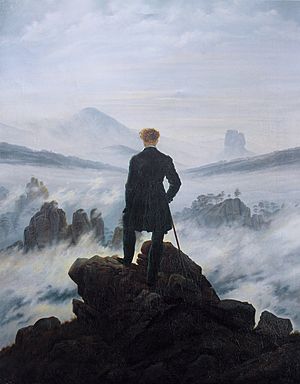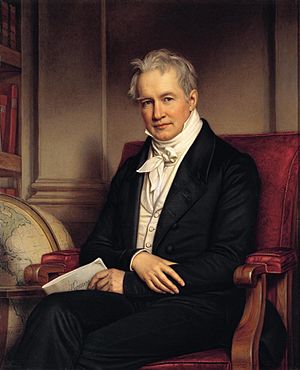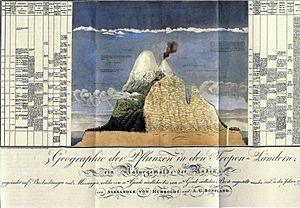Humboldtian science facts for kids

Humboldtian science refers to a movement in science in the 19th century closely connected to the work and writings of German scientist, naturalist and explorer Alexander von Humboldt. The term was coined by Susan Faye Cannon in 1978.
Humboldt had the ability to combine the study of empirical data with a holistic view of nature, which is now held to be the true definition of the study of vegetation and plant geography. Humboldtian science is one of the first techniques for studying both organic and inorganic branches of science. Examining the interconnectedness of vegetation and its respective environment is one of the new and important aspects of Humboldt's work, an idea labeled as "terrestrial physics," something that scientists who preceded him, such as Linnaeus, failed to do.
Humboldtian science is founded on a principle of "general equilibrium of forces." General equilibrium was the idea that there are infinite forces in nature that are in constant conflict, yet all forces balance each other out. Humboldt laid the groundwork for future scientific endeavors by establishing the importance of studying organisms and their environment in conjunction .
Contents
Brief biography
Humboldt was born in Berlin in 1769 and worked as a Prussian mining official in the 1790s until 1797 when he quit and began collecting scientific knowledge and equipment. His extensive wealth aided his infatuation with the spirit of Romanticism; he amassed an extensive collection of scientific instruments and tools as well as a sizeable library. In 1799 Humboldt, under the protection of King Charles IV of Spain, left for South America and New Spain, toting all of his tools and books. The purpose of the voyage was steeped in Romanticism; Humboldt intended to investigate how the forces of nature interact with one another and find out about the unity of nature. Humboldt returned to Europe in 1804 and was acclaimed as a public hero. The details and findings of Humboldt's journey were published in his Personal Narrative of Travels to the Equatorial Regions of the New Continent (30 volumes). This Personal Narrative was taken by Charles Darwin on his famous voyage on H.M.S Beagle. Humboldt spent the rest of his life mainly in Europe, although he did embark on a short expedition to Siberia and the Russian steppes in 1829. Humboldt's last works were contained in his book, Kosmos: Entwurf einer physischen Weltbeschreibung ("Cosmos. Sketch for a Physical Description of the Universe").
Humboldtian science defined
Humboldtian science includes both the extensive work of Alexander von Humboldt, as well as many of the works of 19th century scientists. Susan Cannon is attributed with coining the term Humboldtian science.
Cannon identifies four distinctive features that marked Humboldtian science out from previous versions of science:
- insistence on accuracy for all scientific instruments and observations;
- a mental sophistication in which theoretical mechanisms and entities of past science were taken lightly;
- a new set of conceptual tools, including isomaps, graphs, and a theory of errors;
- the application of accuracy, mental sophistication, and tools not to isolated science in laboratories, but to greatly variable real phenomena.
Humboldt's "terrestrial physicist"
Humboldt was committed to what he called 'terrestrial physics.' Essentially Humboldt's new scientific approach required a new type of scientist: Humboldtian science demanded a transition from the naturalist to the physicist. Humboldt did not consider himself an explorer, but rather a scientific traveler, who accurately measured what explorers had reported inaccurately. According to Humboldt, the goal of the terrestrial physicist was to investigate the interweaving of all physical forces. An incredibly extensive array of precise instrumentation had to be readily available for Humboldt's terrestrial physicist. Just some of such instruments included chronometers, telescopes, sextants, microscopes, magnetic compasses, thermometers, hygrometers, barometers, electrometers, and eudiometers. Furthermore, it was necessary to have multiple makes and models of each specific instrument to compare errors and constancy among each type.
Humboldt's equilibrium
One concept that is central to Humboldtian science is that of a general equilibrium of forces. Humboldtian science promotes the idea that the more forces that are accurately measured over more of the earth's surface results in a greater understanding of the order of nature.
The voyage to the Americas produced many discoveries and developments that help to illustrate Humboldt's ideas about this equilibrium of forces. Humboldt produced the Tableau physique des Andes ("Physical Profile of the Andes), which aimed at capturing his voyage to the Americas in a single graphic table. Humboldt meant to capture all of the physical forces, from organisms to electricity, in this single table.
Humboldt's study of plants provides an example of the movement of Humboldtian science away from traditional science. Humboldt's botany also further illustrates the concept of equilibrium and the Humboldtian ideas of the interrelationship of nature's elements. Although he was concerned with physical features of plants, he was largely focused on the investigation of underlying connections and relations among plant organisms.
Transformation of Humboldtian science
Ralph Waldo Emerson once dubbed Humboldt to be "one of those wonders of the world… who appear from time to time, as if to show us the possibilities of the human mind."
Humboldt is often considered one of the world's first genuine ecologists. Humboldt's work reached far beyond his personal expeditions and discoveries. Figures from all across the globe participated on his work. Humboldt's projects, particularly those related to natural philosophy, played a significant role in the influx of European money and travelers to Spanish America in increasing numbers in the early 19th century.
The promotion and development of terrestrial physics under Humboldtian science produced not only useful maps and statistics, but offered both European and Creole societies tools for essentially 're-imaging' America. The lasting impact of Humboldtian science is described in Cultures of Natural History, "Humboldtian science illuminates the reorganization of knowledge and disciplines in the early nineteenth century that defined the emergence of natural history out of natural philosophy."
See also
- History of biology
- History of ecology
- History of geography
- History of geology
- Romanticism
- Romanticism in science




